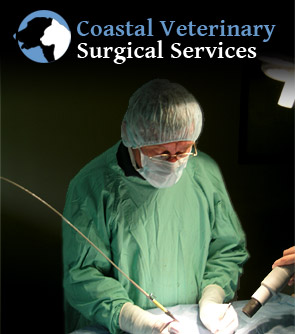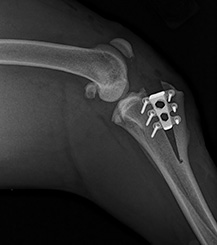 |
|
TTA – Tibial Tuberosity Advancement Better results than lateral suture Less costly and traumatic than TPLO Relatively fast return to function Effective even in large breeds Just as in the human knee, one of the most critical stabilizing structures in the canine knee is the cranial cruciate ligament (CCL or ACL). The primary function of the CCL is to prevent forward thrusting motion and inward rotation of the tibia during weight bearing and to prevent hyper-extension of the knee. When the CCL is ruptured or partially torn, the abnormal, forward thrusting motion and inward rotation of the tibia during weight bearing results in an unstable, painful knee and ultimately, in debilitating, degenerative arthritic changes in the knee joint. Accurate diagnosis and prompt surgical intervention of this serious injury is the current standard of care. Over the years many procedures have been used to treat cruciate tears. In recent years surgeons prefer the TTA or TPLO. The TTA is less invasive and costs almost less than half of a TPLO. TTA patients typically return to function faster than those undergoing TPLO or lateral suture procedures. X-rays to measure the angular relationship of the bones in the knee are needed to determine which procedure is optimal for the patient.
Please call me at 860-449-1873 if your dog has a torn CCL. I’ll be happy to discuss the situation with you, provide an estimate and arrange to see your dog as soon as possible. Earl J Mummert MS, DVM |
||||||||||||||||||||
| ©2014 Coastal Veterinary Surgical Services, a division of Companion Animal Hospital, all rights reserved Designed by Animal Doctor Design Home . Services . About Us . Contact |


 By advancing the tibial tuberosity (the bone just below the knee cap) the dynamic forces in the joint are changed to provide the stability lost when the CCL is torn. The photo shows how a wedge-shaped titanium implant and screws are used to move the tibial tuberosity forward. The spaces are filled with bone graft and in 10-14 weeks new bone grows into the gaps. Full recovery is usually anywhere from 4 to 10 months. As with any knee surgery, strict weight control and physical therapy are important to a good recovery.
By advancing the tibial tuberosity (the bone just below the knee cap) the dynamic forces in the joint are changed to provide the stability lost when the CCL is torn. The photo shows how a wedge-shaped titanium implant and screws are used to move the tibial tuberosity forward. The spaces are filled with bone graft and in 10-14 weeks new bone grows into the gaps. Full recovery is usually anywhere from 4 to 10 months. As with any knee surgery, strict weight control and physical therapy are important to a good recovery.